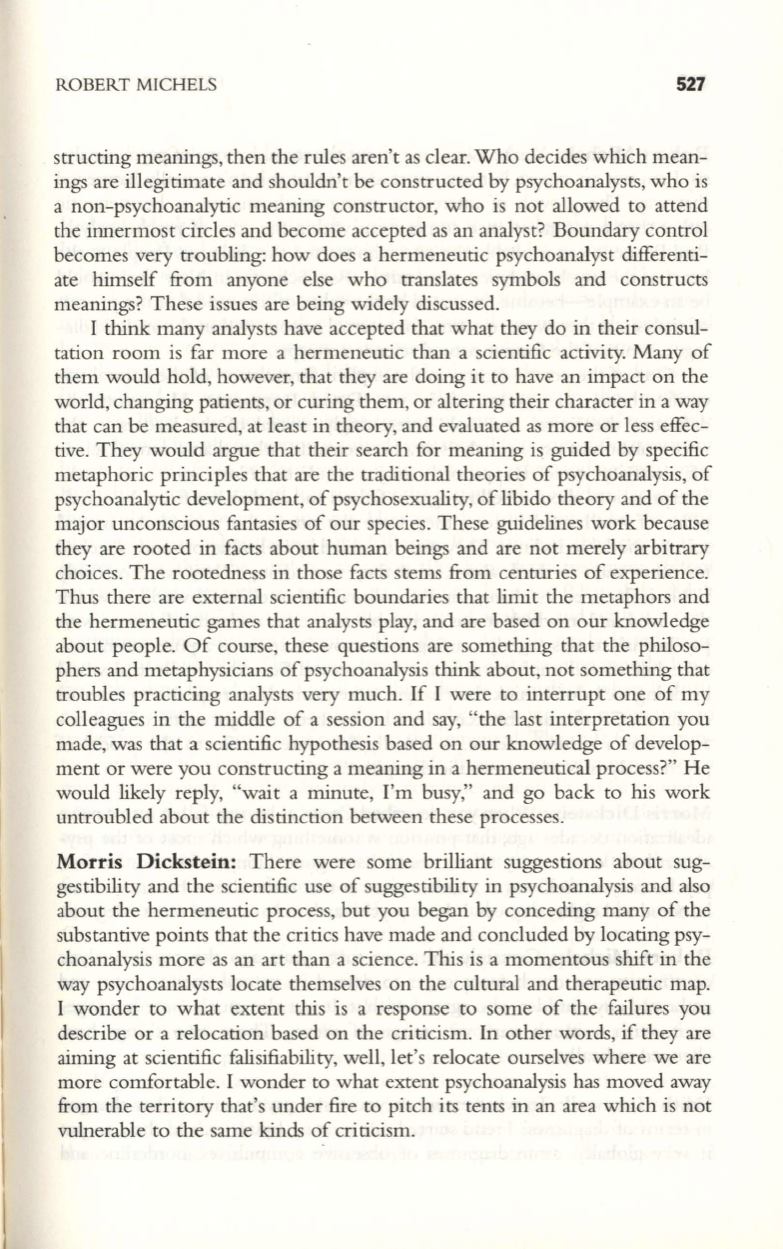
ROBERT MICHELS
527
structing meanings, then the rules aren't as clear. Who decides which mean–
ings are illegitimate and shouldn't be constructed by psychoanalysts, who is
a non-psychoanalytic meaning constructor, who is not allowed to attend
the innermost circles and become accepted as an analyst? Boundary control
becomes very troubling: how does a hermeneutic psychoanalyst differenti–
ate himself from anyone else who translates symbols and constructs
meanings? These issues are being widely discussed.
I think many analysts have accepted that what they do in their consul–
tation room is far more a hermeneutic than a scientific activity. Many of
them would hold, however, that they are doing it to have an impact on the
world, changing patients, or curing them, or altering their character in a way
that can be measured, at least in theory, and evaluated as more or less effec–
tive. They would argue that their search for meaning is guided by specific
metaphoric principles that are the traditional theories of psychoanalysis, of
psychoanalytic development, of psychosexuali ty, of libido theory and of the
major unconscious fantasies of our species. These guidelines work because
they are rooted in facts about human beings and are not merely arbitrary
choices. The rootedness in those facts stems from centuries of experience.
Thus there are external scientific boundaries that limit the metaphors and
the hermeneutic games that analysts play, and are based on our knowledge
about people. Of course, these questions are something that the philoso–
phers and metaphysicians of psychoanalysis think about, not something that
troubles practicing analysts very much. If I were to interrupt one of my
colleagues in the middle of a session and say, "the last interpretation you
made, was that a scientific hypothesis based on our knowledge of develop–
ment or were you constructing a meaning in a hermeneutical process?" He
would likely reply, "wait a minute, I'm busy," and go back to his work
untroubled about the distinction between these processes.
Morris Dickstein:
There were some brilliant suggestions about sug–
gestibility and the scientific use of suggestibility in psychoanalysis and also
about the hermeneutic process, but you began by conceding many of the
substantive points that the critics have made and concluded by locating psy–
choanalysis more as an art than a science. This is a momentous shift in the
way psychoanalysts locate themselves on the cultural and therapeutic map.
I wonder to what extent this is a response to some of the failures you
describe or a relocation based on the criticism. In other words, if they are
aiming at scientific falisifiability, well, let's relocate ourselves where we are
more comfortable. I wonder to what extent psychoanalysis has moved away
from the territory that's under fire to pitch its tents
in
an area which is not
vulnerable to the same kinds of criticism.


